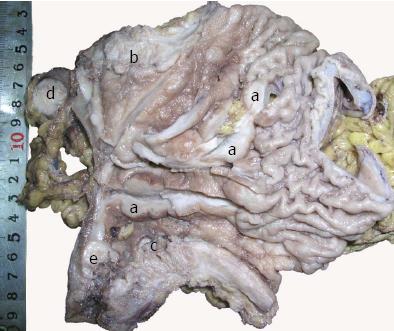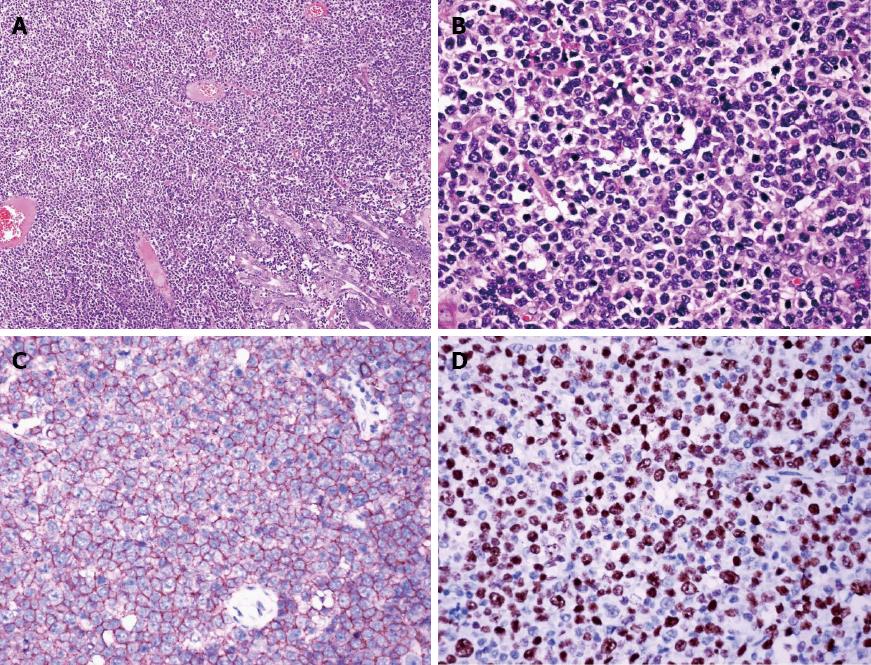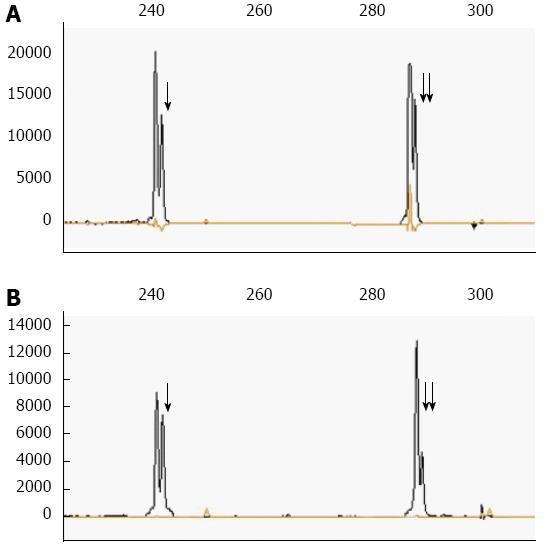Copyright
©2013 Baishideng Publishing Group Co.
World J Gastroenterol. Oct 7, 2013; 19(37): 6304-6309
Published online Oct 7, 2013. doi: 10.3748/wjg.v19.i37.6304
Published online Oct 7, 2013. doi: 10.3748/wjg.v19.i37.6304
Figure 1 Gastroscopy showing an irregular ulcer covered with white exudates (A) and multiple mucosal nodularities in the gastric corpus (B) and a circular ulcer in the gastric pyloric canal (C).
Figure 2 Macroscopic findings of the lesions.
Multiple mucosal nodularities (a) and an ulcer (b) in the gastric corpus, a circular ulcer in the gastric pyloric canal (c), perigastric (d) and parapyloric (e) swollen lymph nodes.
Figure 3 Diffuse large B-cell lymphoma of the stomach.
A: Large lymphoid cells diffusely infiltration the gastric corpus wall (HE, × 100); B: Nucleoli and frequent mitotic figures (HE, × 400); C: Neoplastic cells diffusely positive for CD20 (immunoperoxidase stain, × 400); D: Nuclear proliferation rate as assessed by Ki-67 staining was approximately 80% (immunoperoxidase stain, × 400). HE: Hematoxylin and eosin.
Figure 4 Classical Hodgkin’s lymphoma of the stomach.
A: Mixed lymphocyte, eosinophil granulocyte and neutrophil granulocyte infiltrateing the gastric pyloric canal wall (HE, × 200); B: Hodgkin and Reed-Sternberg (RS) cells are present (HE, × 400); C, D: Hodgkin and RS cells positive for CD30 and CD15, respectively (immunoperoxidase stain, × 400). HE: Hematoxylin and eosin.
Figure 5 Polymerase chain reaction analysis from the two distinct components of the tumor demonstrated clonal immunoglobulin κ light chain gene rearrangements.
The asterisks indicate two peaks representing the rearranged polymerase chain reaction products from position 241 bp (arrow) and 281 bp (double arrows) regions of immunoglobulin κ light chain gene, respectively. A: DNA from the dissected diffuse large B-cell lymphoma component. B: DNA from the dissected classical Hodgkin lymphoma component.
- Citation: Wang HW, Yang W, Wang L, Lu YL, Lu JY. Composite diffuse large B-cell lymphoma and classical Hodgkin’s lymphoma of the stomach: Case report and literature review. World J Gastroenterol 2013; 19(37): 6304-6309
- URL: https://www.wjgnet.com/1007-9327/full/v19/i37/6304.htm
- DOI: https://dx.doi.org/10.3748/wjg.v19.i37.6304













